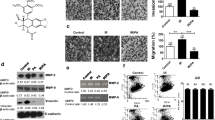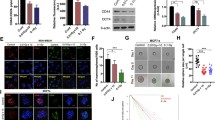Abstract
Radiotherapy, a major treatment modality against cancer, can lead to secondary malignancies but it is uncertain as to whether tumor cells that survive ionizing radiation (IR) treatment undergo epithelial–mesenchymal transition (EMT) and eventually become invasive or metastatic. Here, we have tested the hypothesis that the application of IR (10 MeV photon beams, 2–20 Gy) to lung and pancreatic carcinoma cells induces a migratory/invasive phenotype in these cells by hyperactivation of TGF-β and/or activin signaling. In accordance with this assumption, IR induced gene expression patterns and migratory responses consistent with an EMT phenotype. Moreover, in A549 cells, IR triggered the synthesis and secretion of both TGF-β1 and activin A as well as activation of intracellular TGF-β/activin signaling as evidenced by Smad phosphorylation and transcriptional activation of a TGF-β-responsive reporter gene. These responses were sensitive to SB431542, an inhibitor of type I receptors for TGF-β and activin. Likewise, specific antibody-mediated neutralization of soluble TGF-β, or dominant-negative inhibition of the TGF-β receptors, but not the activin type I receptor, alleviated IR-induced cell migration. Moreover, the TGF-β-specific approaches also blocked IR-dependent TGF-β1 secretion, Smad phosphorylation, and reporter gene activity, collectively indicating that autocrine production of TGF-β(s) and subsequent activation of TGF-β rather than activin signaling drives these changes. IR strongly sensitized cells to further increase their migration in response to recombinant TGF-β1 and this was accompanied by upregulation of TGF-β receptor expression. Our data raise the possibility that hyperactivation of TGF-β signaling during radiotherapy contributes to EMT-associated changes like metastasis, cancer stem cell formation and chemoresistance of tumor cells.










Similar content being viewed by others
Abbreviations
- ALK5:
-
Activin receptor-like kinase 5
- EMT:
-
Epithelial–mesenchymal transition
- IR:
-
Irradiation
- MAPK:
-
Mitogen-activated protein kinase
- PAI-1:
-
Plasminogen activator inhibitor-1
- PDAC:
-
Pancreatic ductal adenocarcinoma
- TBP:
-
TATA-box-binding protein
- TGF-β:
-
Transforming growth factor-β
References
Nuevemann D, Christgen M, Ungefroren H, Kalthoff H (2006) Stable expression of temperature-sensitive p53: a suitable model to study wild-type p53 function in pancreatic carcinoma cells. Oncol Rep 16:575–579
Nieder AM, Porter MP, Soloway MS (2009) Radiation therapy for prostate cancer increases subsequent risk of bladder and rectal cancer: a population based cohort study. J Urol 180:2005-2009 (discussion 2009–2010)
von Essen CF (1991) Radiation enhancement of metastasis: a review. Clin Exp Metastasis 9:77–104
Madani I, De Neve W, Mareel M (2008) Does ionizing radiation stimulate cancer invasion and metastasis? Bull Cancer 95:292–300
Scheel C, Weinberg RA (2012) Cancer stem cells and epithelial-mesenchymal transition: concepts and molecular links. Semin Cancer Biol 22:396–403
Gomez-Casal R, Bhattacharya C, Ganesh N, Bailey L, Basse P, Gibson M, Epperly M, Levina V (2013) Non-small cell lung cancer cells survived ionizing radiation treatment display cancer stem cell and epithelial-mesenchymal transition phenotypes. Mol Cancer 12:94
Wang Z, Li Y, Ahmad A, Banerjee S, Azmi AS, Kong D, Sarkar FH (2011) Pancreatic cancer: understanding and overcoming chemoresistance. Nat Rev Gastroenterol Hepatol 8:27–33
Cheng JC, Chou CH, Kuo ML, Hsieh CY (2006) Radiation-enhanced hepatocellular carcinoma cell invasion with MMP-9 expression through PI3K/Akt/NF-kappaB signal transduction pathway. Oncogene 25:7009–7018
Ho JN, Kang GY, Lee SS, Kim J, Bae IH, Hwang SG, Um HD (2010) Bcl-XL and STAT3 mediate malignant actions of gamma-irradiation in lung cancer cells. Cancer Sci 101:1417–1423
Du S, Barcellos-Hoff MH (2013) Tumors as organs: biologically augmenting radiation therapy by inhibiting transforming growth factor β activity in carcinomas. Semin Radiat Oncol. 23:242–251
Dancea HC, Shareef MM, Ahmed MM (2009) Role of Radiation-induced TGF-beta signaling in cancer therapy. Mol Cell Pharmacol. 1:44–56
Hardee ME, Marciscano AE, Medina-Ramirez CM, Zagzag D, Narayana A, Lonning SM, Barcellos-Hoff MH (2012) Resistance of glioblastoma-initiating cells to radiation mediated by the tumor microenvironment can be abolished by inhibiting transforming growth factor-β. Cancer Res 72:4119–4129
Bouquet F, Pal A, Pilones KA, Demaria S, Hann B, Akhurst RJ, Babb JS, Lonning SM, DeWyngaert JK, Formenti SC, Barcellos-Hoff MH (2011) TGFβ1 inhibition increases the radiosensitivity of breast cancer cells in vitro and promotes tumor control by radiation in vivo. Clin Cancer Res 17:6754–6765
Yi JY, Kim MR, Lee J, An YS, Jin YB, Park IC, Chung E, Shin I, Barcellos-Hoff MH (2014) TGF-beta1 protects cells from gamma-IR by enhancing the activity of the NHEJ repair pathway. Mol Cancer Res 13:319–329
Andarawewa KL, Erickson AC, Chou WS, Costes SV, Gascard P, Mott JD, Bissell MJ, Barcellos-Hoff MH (2007) Ionizing radiation predisposes nonmalignant human mammary epithelial cells to undergo transforming growth factor beta induced epithelial to mesenchymal transition. Cancer Res 67:8662–8670
Jung JW, Hwang SY, Hwang JS, Oh ES, Park S, Han IO (2007) Ionising radiation induces changes associated with epithelial-mesenchymal transdifferentiation and increased cell motility of A549 lung epithelial cells. Eur J Cancer 43:1214–1224
Zhou YC, Liu JY, Li J, Zhang J, Xu YQ, Zhang HW, Qiu LB, Ding GR, Su XM, Shi M, Guo GZ (2011) Ionizing radiation promotes migration and invasion of cancer cells through transforming growth factor-beta-mediated epithelial-mesenchymal transition. Int J Radiat Oncol Biol Phys 81:1530–1537
Inman GJ, Nicolás FJ, Callahan JF et al (2002) SB-431542 is a potent and specific inhibitor of transforming growth factor-β superfamily type I activin receptor-like kinase (ALK) receptors ALK4, ALK5, and ALK7. Mol Pharmacol 62:65–74
Laping NJ, Grygielko E, Mathur A et al (2002) Inhibition of transforming growth factor (TGF)-beta1-induced extracellular matrix with a novel inhibitor of the TGF-beta type I receptor kinase activity: SB-431542. Mol Pharmacol 62:58–64
Chen WB, Lenschow W, Tiede K, Fischer JW, Kalthoff H, Ungefroren H (2002) Smad4/DPC4-dependent regulation of biglycan gene expression by transforming growth factor-beta in pancreatic tumor cells. J Biol Chem 277:36118–36128
Mandel K, Seidl D, Rades D, Lehnert H, Gieseler F, Hass R, Ungefroren H (2013) Characterization of spontaneous and TGF-β-induced cell motility of primary human normal and neoplastic mammary cells in vitro using novel real-time technology. PLoS One 8:e56591
Ungefroren H, Sebens S, Giehl K, Helm O, Groth S, Fändrich F, Röcken C, Sipos B, Lehnert H, Gieseler F (2014) Rac1b negatively regulates TGF-β1-induced cell motility in pancreatic ductal epithelial cells by suppressing Smad signalling. Oncotarget 5:277–290
Forrester HB, Ivashkevich A, McKay MJ, Leong T, de Kretser DM, Sprung CN (2013) Follistatin is induced by ionizing radiation and potentially predictive of radiosensitivity in radiation-induced fibrosis patient derived fibroblasts. PLoS One 8:e77119
Knaus PI, Lindemann D, DeCoteau JF, Perlman R, Yankelev H, Hille M, Kadin ME, Lodish HF (1996) A dominant inhibitory mutant of the type II transforming growth factor beta receptor in the malignant progression of a cutaneous T-cell lymphoma. Mol Cell Biol 16:3480–3489
Zhang Q, Yu N, Lee C (2014) Vicious cycle of TGF-β signaling in tumor progression and metastasis. Am J Clin Exp Urol 2:149–155
Loomans HA, Andl CD (2014) Intertwining of activin A and TGFβ signaling: dual roles in cancer progression and cancer cell invasion. Cancers (Basel) 7:70–91
O’Malley Y, Zhao W, Barcellos-Hoff MH, Robbins ME (1999) Radiation-induced alterations in rat mesangial cell Tgfb1 and Tgfb3 gene expression are not associated with altered secretion of active Tgfb isoforms. Radiat Res 152:622–628
Martin M, Vozenin MC, Gault N, Crechet F, Pfarr CM, Lefaix JL (1997) Coactivation of AP-1 activity and TGF-beta1 gene expression in the stress response of normal skin cells to ionizing radiation. Oncogene 15:981–989
Ogino H, Yano S, Kakiuchi S, Muguruma H, Ikuta K, Hanibuchi M, Uehara H, Tsuchida K, Sugino H, Sone S (2008) Follistatin suppresses the production of experimental multiple-organ metastasis by small cell lung cancer cells in natural killer cell-depleted SCID mice. Clin Cancer Res 14:660–667
Planque C, Kulasingam V, Smith CR, Reckamp K, Goodglick L, Diamandis EP (2009) Identification of five candidate lung cancer biomarkers by proteomics analysis of conditioned media of four lung cancer cell lines. Mol Cell Proteomics 8:2746–2758
Chen F, Ren P, Feng Y, Liu H, Sun Y, Liu Z, Ge J, Cui X (2014) Follistatin is a novel biomarker for lung adenocarcinoma in humans. PLoS One 9:e111398
Ahmed MM, Alcock RA, Chendil D et al (2002) Restoration of transforming growth factor-beta signaling enhances radiosensitivity by altering the Bcl-2/Bax ratio in the p53 mutant pancreatic cancer cell line MIA PaCa-2. J Biol Chem 277:2234–2246
Drabsch Y, ten Dijke P (2012) TGF-β signalling and its role in cancer progression and metastasis. Cancer Metastasis Rev 31:553–568
Bloom BB, Humphries DE, Kuang PP, Fine A, Goldstein RH (1996) Structure and expression of the promoter for the R4/ALK5 human type I transforming growth factor-beta receptor: regulation by TGF-beta. Biochim Biophys Acta 1312:243–248
Andarawewa KL, Paupert J, Pal A, Barcellos-Hoff MH (2007) New rationales for using TGFbeta inhibitors in radiotherapy. Int J Radiat Biol 83:803–811
Calone I, Souchelnytskyi S (2012) Inhibition of TGFβ signaling and its implications in anticancer treatments. Exp Oncol 34:9–16
Zhang M, Lahn M, Huber PE (2012) Translating the combination of TGFβ blockade and radiotherapy into clinical development in glioblastoma. Oncoimmunology 1:943–945
Acknowledgments
We are indebted to H. Albrecht and S. Grammerstorf-Rosche for excellent technical assistance. We thank Drs. J. Massagué (NY), K. Miyazono (Tokyo, Japan), C.-H. Heldin (Uppsala, Sweden) and P. Knaus (Berlin, Germany) for generously providing plasmid vectors.
Author information
Authors and Affiliations
Corresponding author
Additional information
C. Carl and A. Flindt contributed equally.
F. Gieseler and H. Ungefroren contributed equally.
Electronic supplementary material
Below is the link to the electronic supplementary material.
Rights and permissions
About this article
Cite this article
Carl, C., Flindt, A., Hartmann, J. et al. Ionizing radiation induces a motile phenotype in human carcinoma cells in vitro through hyperactivation of the TGF-beta signaling pathway. Cell. Mol. Life Sci. 73, 427–443 (2016). https://doi.org/10.1007/s00018-015-2003-2
Received:
Revised:
Accepted:
Published:
Issue Date:
DOI: https://doi.org/10.1007/s00018-015-2003-2




